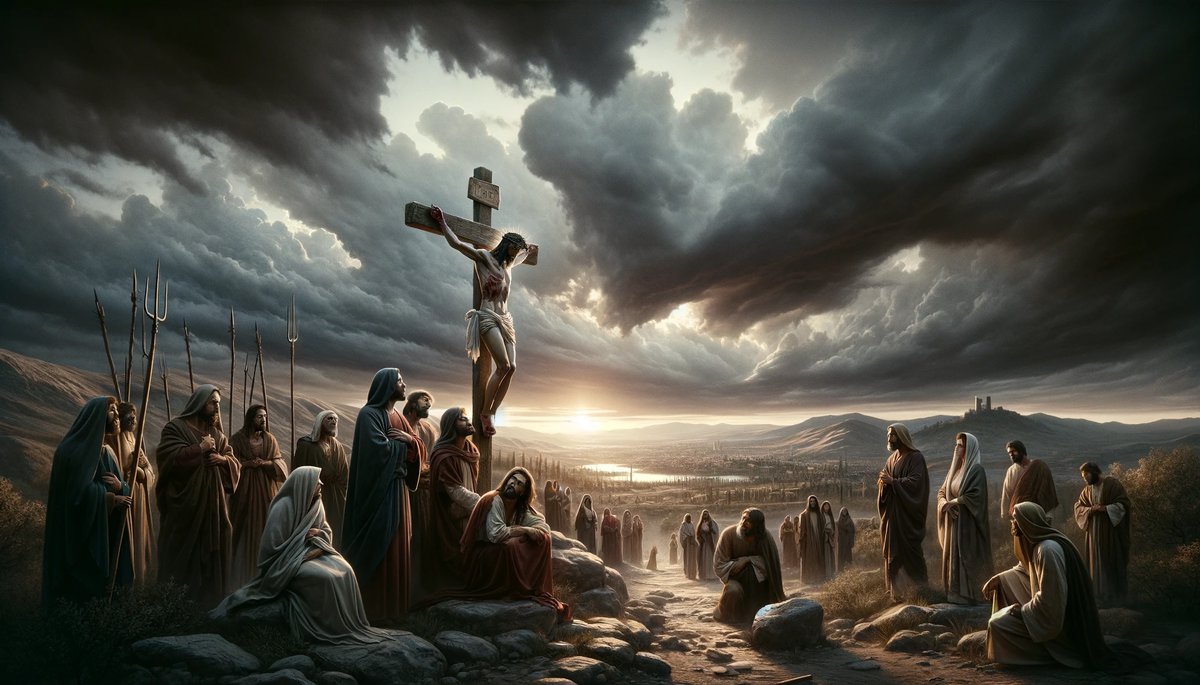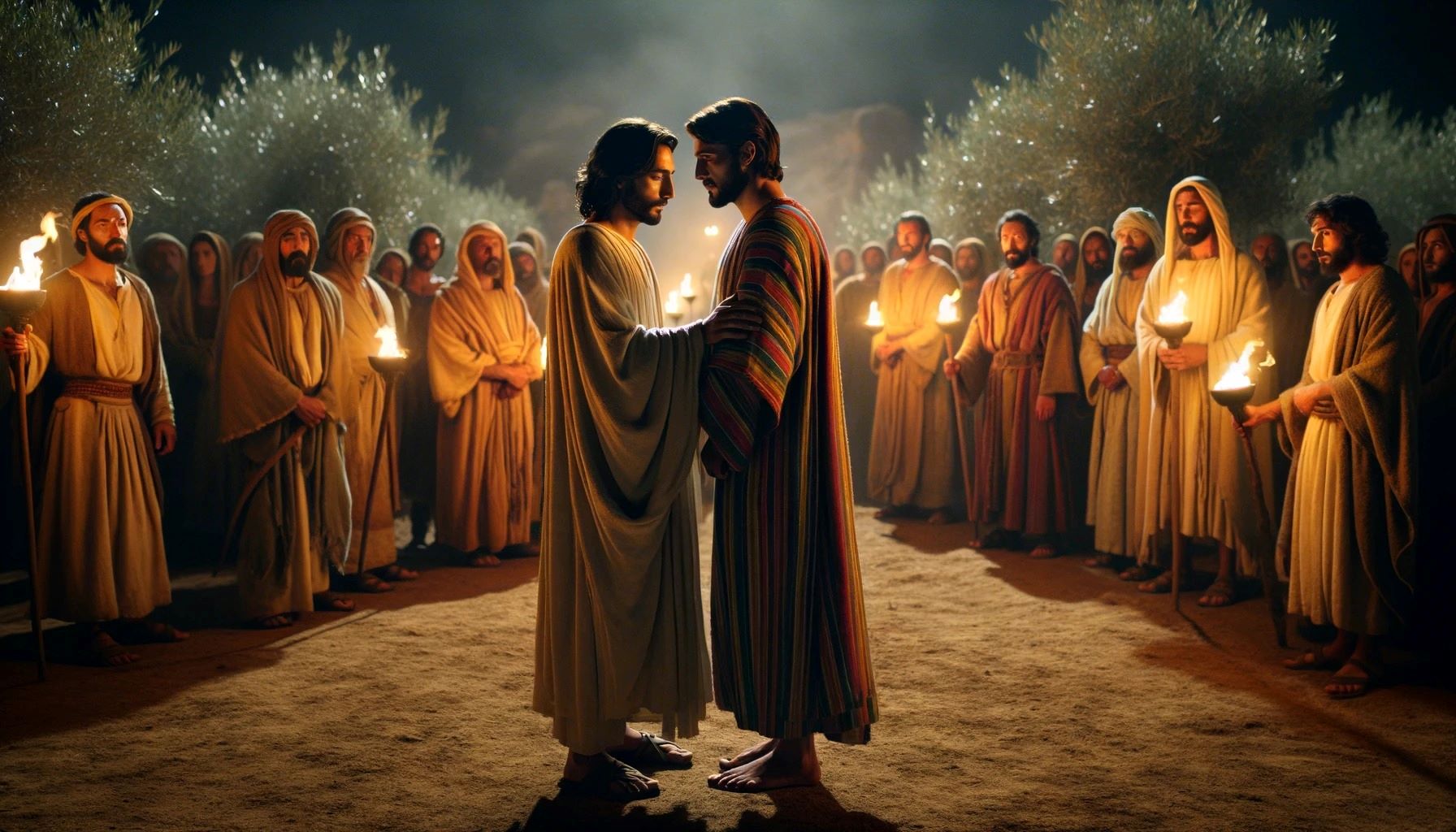Home>Christian Videos>Bible Stories>Who Crucified Jesus Christ On The Cross


Bible Stories
Who Crucified Jesus Christ On The Cross
Published: March 1, 2024
Jason DeRose, Managing Editor at Christian.net, uses his expertise in religion and journalism to deepen understanding of faith's societal impacts. His editorial leadership, coupled with a strong academic background, enriches the platform’s diverse content, earning him recognition in both journalism and religious circles.
Discover the biblical account of who crucified Jesus Christ on the cross and explore the significance of this pivotal event in Christian history. Uncover the timeless lessons from this powerful Bible story.
(Many of the links in this article redirect to a specific reviewed product. Your purchase of these products through affiliate links helps to generate commission for Christian.net, at no extra cost. Learn more)
Table of Contents
The Accusations Against Jesus
-
Blasphemy: Jesus was accused of claiming to be the Son of God, which was considered blasphemy by the Jewish religious leaders. They saw His teachings and claims as a direct challenge to their authority and the established religious order.
-
Political Subversion: Some accused Jesus of stoking rebellion against the Roman authorities by proclaiming Himself as the King of the Jews. This was a direct challenge to the rule of the Roman Empire, and it was a serious accusation in the political climate of the time.
-
False Witness: The accusations against Jesus included false witness and manipulation of the truth. Many of the charges brought against Him were based on twisted or fabricated accounts, as some sought to find any reason to condemn Him.
-
Sedition: Jesus' growing influence and following posed a threat to the status quo, leading to accusations of sedition. His teachings and actions were seen as seditious by those in power, especially when they contradicted the established religious and political norms.
-
Challenging Traditions: Jesus' teachings often challenged the traditional interpretations of the Jewish law and customs, leading to accusations of undermining the religious traditions and practices that were deeply ingrained in the society at that time.
-
Healing on the Sabbath: Jesus' acts of healing on the Sabbath were seen as a violation of the religious laws and customs, leading to accusations of disregarding the sacredness of the Sabbath day and the traditions associated with it.
These accusations against Jesus set the stage for the events that ultimately led to His crucifixion, as they fueled the animosity and opposition against Him from various quarters.
Read more: Who Helped Jesus Christ Carry The Cross
The Role of Pontius Pilate
-
Political Pressure: Pontius Pilate, the Roman governor of Judea, played a pivotal role in the trial and crucifixion of Jesus. As the representative of Roman authority in the region, Pilate faced immense political pressure to maintain order and stability. The volatile atmosphere surrounding Jesus' trial, with the accusations of sedition and claims of kingship, placed Pilate in a challenging position. He had to navigate the delicate balance between appeasing the Jewish religious leaders and addressing the concerns of the Roman Empire.
-
Reluctant Decision: Pilate's reluctance to condemn Jesus is evident in the Gospel accounts. Despite the mounting pressure from the Jewish leaders, Pilate found no basis for the charges brought against Jesus. His attempts to release Jesus, such as offering the release of a prisoner during the Passover, reflect his reluctance to execute an innocent man. However, the relentless insistence of the crowd and the fear of potential unrest ultimately influenced his decision.
-
Symbolic Washing of Hands: The symbolic act of washing his hands, as described in the Gospels, illustrates Pilate's attempt to distance himself from the responsibility of Jesus' fate. This gesture, while symbolic, underscores Pilate's recognition of the unjust nature of the proceedings and his attempt to absolve himself of the guilt associated with the decision to crucify Jesus.
-
Political Expediency: Pilate's decision to crucify Jesus can be seen as a calculated move to maintain his position and appease the influential Jewish leaders and the Roman authorities. By sacrificing Jesus, Pilate sought to quell potential unrest and secure his standing with the higher echelons of power. The political expediency of his decision highlights the complex interplay of political dynamics and personal ambition in the events leading to the crucifixion.
-
Historical Controversy: The role of Pontius Pilate in the crucifixion of Jesus has been a subject of historical and theological debate. While some view Pilate as a reluctant figure caught in a web of political intrigue, others criticize his willingness to sacrifice justice for the sake of expediency. Regardless of the differing perspectives, Pilate's role in the crucifixion of Jesus remains a significant aspect of the narrative, shedding light on the complexities of power, morality, and the human condition.
The Involvement of the Jewish Religious Leaders
-
Opposition to Jesus: The Jewish religious leaders, including the chief priests, scribes, and Pharisees, played a central role in the events leading to the crucifixion of Jesus. Their opposition to Jesus stemmed from various factors, including His teachings that challenged their authority and interpretations of the law. They viewed Jesus as a threat to the established religious order and sought to discredit and eliminate Him.
-
Charges of Blasphemy: The religious leaders accused Jesus of blasphemy for claiming to be the Son of God and for His teachings that they perceived as undermining the traditional religious norms. His assertion of divine authority and His acts of forgiveness and healing were seen as blasphemous by the religious establishment, leading to their vehement opposition and calls for His condemnation.
-
Manipulation of the Legal System: The Jewish religious leaders manipulated the legal proceedings against Jesus to ensure His condemnation. Their desire to eliminate Jesus led to a series of orchestrated events, including false testimonies and a biased trial, aimed at securing a guilty verdict. The manipulation of the legal system reflected their determination to see Jesus crucified.
-
Political Collaboration: The collaboration between the Jewish religious leaders and the Roman authorities was instrumental in the crucifixion of Jesus. The religious leaders leveraged their influence to pressurize Pontius Pilate, the Roman governor, into condemning Jesus. Their strategic maneuvering and political collaboration with the Roman authorities contributed to the eventual crucifixion of Jesus.
-
Rejection of Jesus' Authority: The religious leaders' rejection of Jesus' authority and claims of divinity fueled their determination to see Him crucified. Their refusal to accept Jesus as the Messiah and their insistence on His condemnation demonstrated the depth of their opposition. Their involvement in the events leading to the crucifixion highlights the clash between Jesus' message and the entrenched religious hierarchy of the time.
-
Spiritual Blindness: The actions of the religious leaders also reflect a form of spiritual blindness, as they failed to recognize the true nature of Jesus' mission and message. Their preoccupation with preserving their own authority and traditions led them to overlook the profound spiritual significance of Jesus' teachings and actions. This spiritual blindness contributed to their active role in the events that culminated in the crucifixion of Jesus.
The involvement of the Jewish religious leaders in the events leading to the crucifixion of Jesus underscores the complex interplay of religious, political, and spiritual dynamics. Their opposition, manipulation of the legal system, and collaboration with the Roman authorities all contributed to the fulfillment of the prophetic narrative of Jesus' crucifixion.
The Actions of the Roman Soldiers
-
Carrying Out the Execution: The Roman soldiers were responsible for the actual crucifixion of Jesus. Following the orders of their superiors, they carried out the execution with precision and efficiency. The process of crucifixion, a brutal form of punishment, was executed by the soldiers with a chilling sense of routine, highlighting the stark reality of the Roman occupation and the exercise of imperial power.
-
Infliction of Suffering: The soldiers, in their role as executioners, inflicted immense suffering upon Jesus. From the scourging to the nailing of Jesus to the cross, their actions were marked by a callous disregard for human dignity. The physical torment and agony endured by Jesus at the hands of the Roman soldiers underscore the brutality and inhumanity inherent in the practice of crucifixion.
-
Division of Garments: The Gospels recount the soldiers' callous act of dividing Jesus' garments among themselves, casting lots for His seamless tunic. This callous display of indifference to the plight of the condemned further emphasizes the dehumanizing treatment meted out by the soldiers. The division of Jesus' garments serves as a poignant symbol of the profound injustice and disregard for basic human decency that characterized the events surrounding His crucifixion.
-
Mockery and Ridicule: In addition to the physical torment, the soldiers subjected Jesus to mockery and ridicule. They taunted Him, challenging His claim to kingship and divine authority. Their derisive actions, such as placing a crown of thorns on His head and hailing Him as the "King of the Jews," exemplified the cruel mockery inflicted upon Jesus as He hung on the cross, bearing the weight of the world's sins.
-
Fulfillment of Prophecy: The soldiers' actions, while driven by their duty to carry out the crucifixion, unwittingly contributed to the fulfillment of prophetic scriptures. The division of Jesus' garments and the fulfillment of specific details foretold in the Old Testament underscore the profound significance of these events in the broader narrative of Jesus' redemptive mission.
-
Symbol of Human Cruelty: The actions of the Roman soldiers serve as a stark symbol of the depths of human cruelty and the capacity for indifference to the suffering of others. Their role in the crucifixion of Jesus encapsulates the broader themes of injustice, inhumanity, and the redemptive significance of Jesus' sacrificial death.
The actions of the Roman soldiers in the crucifixion of Jesus exemplify the complex interplay of historical, religious, and human elements, shedding light on the profound significance of these events in the Christian faith.
The Betrayal by Judas Iscariot
-
Collaboration with the Authorities: Judas Iscariot, one of the twelve disciples of Jesus, infamously betrayed his teacher and mentor. His collaboration with the religious authorities, particularly the chief priests, to hand over Jesus for thirty pieces of silver stands as a poignant symbol of betrayal. Judas' actions, motivated by greed and disillusionment, set in motion the chain of events that culminated in the crucifixion of Jesus.
-
Act of Deception: Judas' act of betrayal was marked by deception and subterfuge. His decision to identify Jesus to the authorities with a kiss, a gesture of friendship and loyalty, added a layer of treachery to his actions. The betrayal by Judas, a trusted companion of Jesus, underscores the profound sense of betrayal and abandonment experienced by Jesus in the moments leading to His arrest and subsequent crucifixion.
-
Fulfillment of Prophecy: The betrayal by Judas Iscariot, while a deeply tragic event, also fulfilled the prophetic scriptures. The betrayal of Jesus by one of His own disciples, as foretold in the Psalms and the writings of the prophets, serves as a poignant reminder of the overarching narrative of redemption and the fulfillment of divine purpose through the events surrounding the crucifixion.
-
Personal Motivations: Judas' motivations for betraying Jesus have been the subject of speculation and interpretation. While the Gospels highlight his dissatisfaction and disillusionment, the precise reasons behind his betrayal remain a matter of historical and theological inquiry. Judas' actions, whether driven by personal grievances or a misguided understanding of Jesus' mission, carry profound implications for the narrative of the crucifixion.
-
Reflection of Human Frailty: The betrayal by Judas Iscariot serves as a powerful reflection of human frailty and the complexities of human nature. His actions, influenced by a combination of personal weaknesses and external pressures, exemplify the capacity for moral failure and the consequences of succumbing to base instincts. The portrayal of Judas' betrayal offers a sobering portrayal of the human condition and the moral choices that shape the course of history.
-
Redemptive Context: Despite the tragic nature of Judas' betrayal, it is situated within the broader redemptive context of Jesus' sacrificial mission. The betrayal, while a pivotal moment in the events leading to the crucifixion, ultimately becomes part of the redemptive narrative, underscoring the profound themes of forgiveness, grace, and the transformative power of Jesus' ultimate sacrifice.
The betrayal by Judas Iscariot stands as a poignant and complex element in the narrative of the crucifixion, embodying themes of human frailty, divine purpose, and the redemptive significance of Jesus' ultimate sacrifice.















